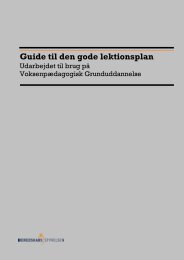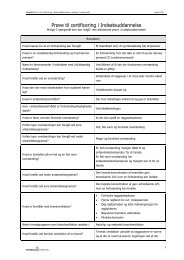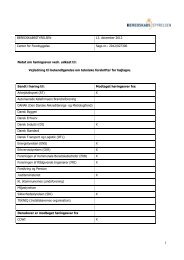Comprehensive Preparedness Planning
Comprehensive Preparedness Planning
Comprehensive Preparedness Planning
You also want an ePaper? Increase the reach of your titles
YUMPU automatically turns print PDFs into web optimized ePapers that Google loves.
Crisis management plans••Establishment of systematic media monitoring and media analysis – partly to contributeto the combined situation picture, partly as basis for press strategies and to ensure thatany errors in the media’s coverage of the organisation are corrected.••Agendas for internal meetings in the crisis communication team.••Involvement of the crisis communication team in the crisis management unit meetings.Press strategy and media coverage should be a fixed item on the agenda.••Permanent contact person for journalists with a fixed telephone number during the crisis(press duty officer).••Contact details for persons in charge of communication at partner organisations.••Prepared drafts for press releases, fact sheets with background information, etc.••Distribution lists for press releases and communication briefings (email).••Instructions regarding who can speak to the media on behalf of the organisation (spokesmanhierarchy), specifying who in the organisation journalists may quote directly, andwho are only allowed to provide background information to the media.••Procedure that, if necessary, dictates a centralisation of all crisis communication to ensure,that the organisation speaks with one voice only.Core task 5: Operational responseIn view of the many and very different organisations in this guide’s target group, the phrase“operational response” must be interpreted as covering a very wide spectrum of emergencyactivities. In most circumstances, however, operational response is either about deployingpersonnel and equipment in the field or performing tactical/operational crisis management, asopposed to the more “strategic” aspects of crisis management inherent in core tasks 1 - 4.When the organisation activates its generalcrisis management plan, the first four coretasks will usually be relatively similar, regardlessof the specific type of incident that hasoccurred. The operational response, on theother hand, will be different from one incidentto another.To avoid an unnecessarily long general crisismanagement plan, we recommend that onlythe most universal principles for operationalresponse are described directly in the plan.Detailed planning for operational responseshould instead appear in customized contingencyplans for different incidents. Eachcontingency plan should deal with the centralaspects of a specific operational response,including:Examples of operational responses:••Visits to elderly or otherwise vulnerablepeople by municipal care personnel in theevent of extreme weather, power cuts, etc.••Provision of clean drinking water after contaminationaccidents.••Control centres’ diversion of mass traffic afterserious accidents.••Resumption of the electricity grid followingserious disruptions.••Re-establishment of compromised IT systemsand networks.••Psychological first aid following serious accidents,violent episodes, or neglect in schools,day care centres, rest homes, etc.••Putting down animals during outbreaks ofveterinary diseases.••Containing and cleaning out hazardous substancesas a result of environmental pollution.••Tasks – Which primary and secondary tasks must be tackled as a part of the response?37
















